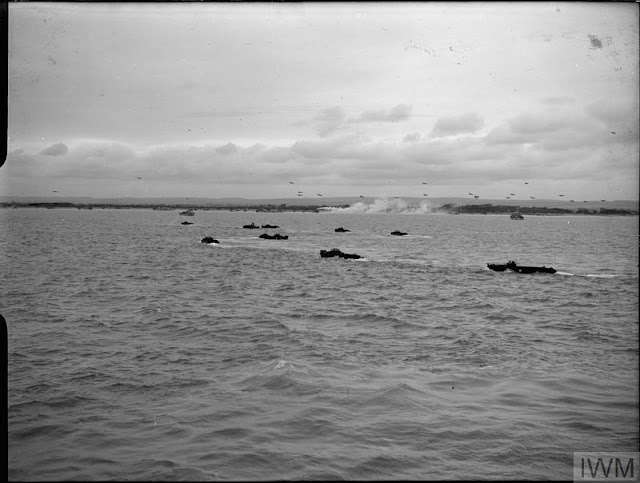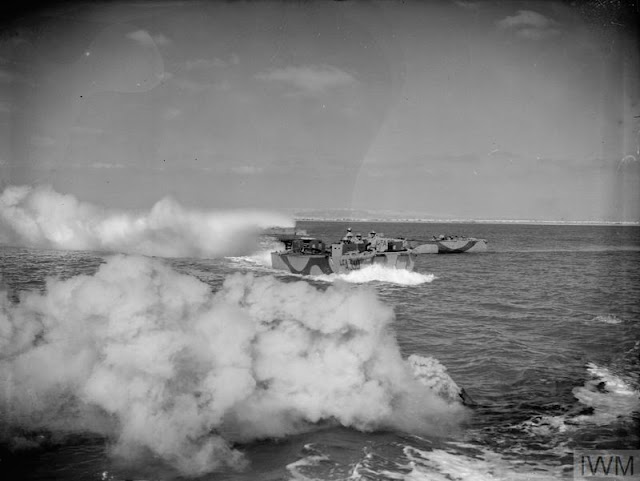Combined Operations Camps, Landing Crafts and Crews.
Details re each camp found at Combined Operations Command.
From Combined Operations by Clayton Marks, London ONT.]
Introduction:
As World War II continued Combined Operation Centres or camps began to dot the shoreline of the United Kingdom. Thousands of men would eventually pass through the doors of some of the more extensive camps, as at HMS Quebec in Scotland and HMS Saunders, at Kabrit, on Bitter Lakes, Egypt.
Canadians in Combined Operations became acquainted with new Landing Craft Infantry (Large), aka LCI(L)s during training exercises in the English Channel near the Isle of Wight prior to D-Day Normandy.
As said in an earlier entry, the number of training centres, the types and sizes of landing craft, and the numbers of men trained to man landing crafts gradually grew as WW2 progressed toward its ultimate conclusion.
In this and subsequent entries, several photographs related to landing crafts will be displayed from the Imperial War Museum (IWM) as found within its extensive and valuable archives. Sites visited by the Canadians in Combined Ops will be featured on occasion.
[Please link to IWM at Search Our Collections and browse at your leisure through photographs, films and audios, etc.]

A23092. Under a bright sun landing craft tanks on the way to the beaches during
pre-invasion fleet exercises in the English Channel in the Portsmouth and Isle
of Wight area. Photograph taken from on board the landing ship infantry
EMPIRE MACE. Lt. E.E. Allen, RN Official Photographer, IWM.
A23093 Under a cover of barrage balloons, landing craft tanks (including LCT 1095,
LCT 1098, LCT 1037 and LCT 1033) passing the EMPIRE LANCE on the way to the
beaches during pre-invasion fleet exercises in the English Channel in the Portsmouth
and Isle of Wight area. A landing craft support (LCS 79) is by the bow of EMPIRE
LANCE. Photo Credit - Lt. E.E. Allen, Imperial War Museum (IWM).
Channel, Portsmouth and Isle of Wight area to prepare for the Normandy
Photo - Lt. E.E. Allen, IWM.
A23096. Landing craft on their way to the beaches during pre-invasion fleet exercises.
Photograph taken from EMPIRE MACE. Lt. E.E. Allen, IWM.
A23097. Troops landing on the beach from an assault craft, Isle of Wight area.
A Duplex Drive Valentine tank is driving up the beach. Lt. E.E. Allen, IWM.
A23098. General view of troops and Valentine tanks storming the beach.
Lt. E.E. Allen, Imperial War Museum.
Below are three photos taken during the invasion of North Africa about one and a half years earlier. One can see the use of anti-broaching ropes to keep landing crafts steady.
D. Harrison wrote the following about his duties while manning landing crafts while in N. Africa, as above:
The job of the seaman on an ALC or LCM is to let the bow door down and wind it up by means of a winch situated in the stern of the barge. This winch is divided so you can drop a kedge (anchor) possibly about 100 or so feet from shore depending on the tide. If it is going out you can unload and then put motors full astern, wind in the kedge and pull yourself off of breach.
A12671. IWM. D. Harrison, Canadian in Combined Ops (centre, in water),
assists US troops, Operation TORCH, November 8, 1942.
The job of the seaman on an ALC or LCM is to let the bow door down and wind it up by means of a winch situated in the stern of the barge. This winch is divided so you can drop a kedge (anchor) possibly about 100 or so feet from shore depending on the tide. If it is going out you can unload and then put motors full astern, wind in the kedge and pull yourself off of breach.
The tide is very important and constantly watched. If it is going out (on the ebb) and you are slow, you can be left high and dry, and if so, you stay with the barge. If the tide is on the make (flowing in) you use the kedge to keep you from swinging sideways on breach. In this case your kedge would be out only a short ways. After much practice, however, the kedge can be forgotten and everything done by engines and helm. Each barge has two engines. (Page 26, "DAD, WELL DONE")
Unloading takes place easily on calm waters. Anti-broaching lines in use.
Photo Credit - IWM.
Anti-broaching line in use as an ALC is unloaded. Photo - IWM
A23099. Tanks on the beach with troops disembarking from an Assault craft.
Lt. E.E. Allen, IWM.
Heading that accompanies many photos - Pre invasion fleet exercises in the English Channel 3 and 4 May 1944, on board LSI Empire Mace, in the Portsmouth and Isle of Wight area.
A23101. Landing craft (Assault) and Landing craft (tanks) on the way to the beaches.
Lt. E.E. Allen, Imperial War Museum (IWM).

A23102. Troops embarking on Landing Craft, Assault from a Landing Craft, Tank.
Lt. E.E. Allen, IWM.
More to follow.
Please link to Photographs: Training on Landing Crafts (5).
Unattributed Photos GH
















































